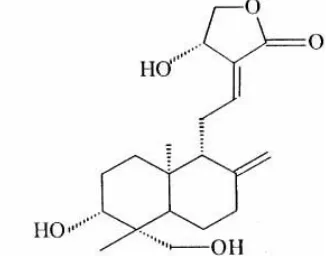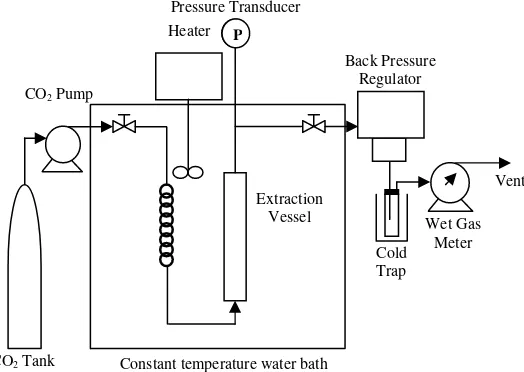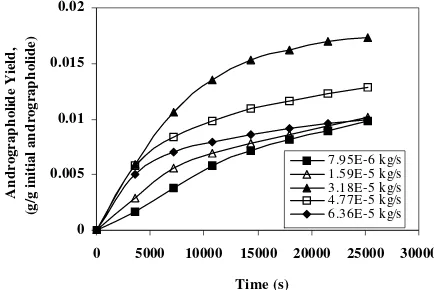EFFECT OF SOLVENT FLOW RATE ON THE SUPERCRITICAL CARBON
DIOXIDE EXTRACTION OF ANDROGRAPHOLIDE
FROM ANDROGRAPHIS PANICULATA
A. C. Kumoro(1, 2) and M. Hasan(2)
(1)
Dept. of Chemical Engineering, Faculty of Engineering, Diponegoro University. Prof. H. Soedarto, SH. Road, Tembalang Campus, Semarang - Indonesia.
Email: [email protected]
(2)
Dept. of Chemical Engineering, Faculty of Engineering, University of Malaya, Pantai Valley 50603 Kuala Lumpur, Malaysia
ABSTRACT
Malaysia is one of the major medicinal plants (Andrographis paniculata) producers in the world. Extraction of bioactive component (andrographolide) from ground dried leaves of this plant using supercritical carbon dioxide has been studied. The effect of solvent flow rates ranging from 7.95 × 10-6 to 6.36 × 10-5
kg/s on the extraction efficiency has been investigated. The extraction yield increased with the increase of solvent flow rate from 7.95 × 10-6 to 3.18 × 10-5
kg/s. However further increase of solvent flow rate reduced the extraction yield. Therefore, an optimum solvent flow rate at 3.18 × 10-5
kg/s was obtained for the system under study. The extraction process was found to be controlled by intraparticle diffusion of the andrographolide in the starting leaves particles.
Keywords: solvent, flow rate, supercritical carbon dioxide, extraction, andrographolide
1. INTRODUCTION
Andrographispaniculata NEES, locally known as Hempedu Bumi grows widely in the tropical area of South East Asia, India and China with plant height of 0.30 – 0.70 m. In these regions, this plant has been extensively used for traditional medicine and help against fever, dysentery, diarrhoea, inflammation, and sore throat (Wongkittipong et al., 2000). Furthermore, it is a promising new way for the treatment of many diseases, including HIV, AIDS, and numerous symptoms associated with immune disorders (Calíbrese et al., 2000).
Andrographolide, the main diterpenoid lactones identified in A. paniculata leaves, is grouped as an unsaturated trihydroxy lactone has molecular formula of C20H30O5 (Choudhury et al., 1987; Rajani et al., 2000). The
molecular structure of andrographolide is shown in Figure 1. Andrographolide can be easily dissolved in methanol, ethanol, pyridine, acetic acid and acetone, but slightly dissolved in ether and water. Its physical properties are; m.p. is 501- 503 K and ultraviolet spectrum in ethanol: λmax is
223 nm (Rajani et al., 2000).
1
Conventional production methods such as solvent extraction and soxhlet, although effective for extraction, can lead to degradation of heat sensitive compounds as well as leave traces of toxic solvents in the solute. This is a concern for food and medicinal extracts (Tonthubthimthong et al.,
2001). Supercritical fluid extraction (SFE) may be a viable alternative to solvent extraction methods. Carbon dioxide is generally the most desirable solvent for supercritical fluid extraction. Its low critical temperature (304.26 K) and pressure (7.38 MPa), make it effective for the extraction of heat sensitive (thermally labile) compounds. In addition, it is an inert, non-flammable, non-explosive, inexpensive, odourless, colourless clean solvent that leaves no solvent residue in the product; it is also non-toxic and is generally accepted as a harmless ingredient in pharmaceuticals and food (Tonthubthimthong et al., 2001). It also has low surface tension and viscosity and high diffusivity, which make it attractive as supercritical solvent (Roy et al., 1996).
Fig. 1. Molecular structure of andrographolide
The diffusivity of supercritical carbon dioxide is one to two orders of magnitude higher than for other fluids, which permits rapid mass transfer, resulting in a larger extraction rate than that obtained by conventional liquid extraction (Tonthubthimthong et al., 2001).
2
The objective of this work is to investigate the effect of supercritical carbon dioxide flow rates on the extraction yield in the supercritical carbon dioxide extraction of andrographolide from A.paniculata.
2. METHODOLOGY
2.1 MATERIAL AND REAGENTS
Dried leaves of A. paniculata were collected from Malaysian Agricultural Research and Development Institute (MARDI) and stored in an air tight sealed container at ambient conditions. Without any pre-treatment the leaves were ground into powder and were sieved to obtain three different particle sizes. The andrographolide standard pure crystals (Purity 980 g/ kg) was supplied by Sigma - Aldrich (M) Sdn. Bhd. Carbon dioxide (999.70 g/ kg) was used as the solvent in this study and was purchased in the liquid form by Air Product (M) Berhad
2.2 SUPERCRITICAL CO2 EXTRACTION
The own built supercritical fluid extraction apparatus used in this study is as described in Fig. 2. It consists of a 1.60 × 10-5 m3 high-pressure stainless steel extraction vessel (10 mm inner diameter × 200 mm length). A reciprocating pump was used to compress and introduce CO2 into the
extraction system. The extraction process can be briefly described as follows: in a typical run, the extraction vessel was first filled with 3.0 g of dried - powdered A. paniculata
leaves distributed in stainless steel balls in order to improve the leaves-solvent contact and to avoid channelling when CO2 flowed through. The extraction vessel was then
immersed in the water bath controlled by an electrical heater (Thermo Haake, model DC10) to within ± 0.1 K and the system was brought to the desired temperature. Liquid CO2
was then charged into high-pressure pump (ISCO, model 260 DM) from the liquid CO2 cylinder. The high-pressure
pump further compressed the CO2 to the desired pressure
and continuously delivered the CO2 to flow through the
sample in the extraction vessel to extract the andrographolide at desired volumetric flow rate. The pressure of the system was determined by a pressure transducer (Druck, model PDCR 961). The extract was collected in a cold trap by depressurising the CO2 at the
backpressure regulator (Jasco, model 880-81). The cold trap was a glass vial immersed in a pack of diced ice that was maintained at 277 K. The samples were taken at one-hour interval and experiments were terminated after seven hours, and the total amount of extract collected was gravimetrically determined using a balance (Mettler Toledo, model AG 204) with an accuracy of ± 0.0001 g. The carbon
dioxide amount consumed was determined using a wet gas meter (Alaxander Wright & Co., model DM 3A). The glass vials were wrapped with aluminium foil to prevent photo degradation of the andrographolide. For each trial, at least two experiments were carried out where the total amount of CO2 that passed through the cell slightly varied, hence
varying the total amount of extract collected. The extracts were then analysed their andrographolide content using high performance liquid chromatography. The relative error obtained between the duplicate experiments was less than 5 %.
3. RESULT AND DISCUSSIONS
In an attempt to investigate the effect of solvent flow rate on the extraction rate, a set of experiments was carried out at 313 K and 10 MPa, while the flow rate of CO2 was varied
from 7.95 × 10-6 to 6.36 × 10-5
kg/s. Figure 3 was constructed to show the effect of time with the flow rate as a parameter. It shows that the yield increases with increase in supercritical carbon dioxide flow rate, reaches a maximum value, and then decreases with further increase in the flow rate. The results obtained here can be explained as a trade-off between a mass transfer process and a thermodynamic equilibrium state. The interface gas phase concentration of the solute is a function of the mass transfer coefficient, or solvent flow rate, while equilibrium state is favoured by both high mass transfer rate and long residence time (Elkanzi and Singh, 2001). At low flow rates of the solvent, the mass transfer resistance limits the amount of solute transported into the bulk of the solvent and the supercritical carbon dioxide leaves the extractor unsaturated. As the flow rate is increased, mass transfer resistance continues to decrease until exiting solvent is saturated; and let equilibrium to be achieved and hence the maximum yield is attained. Further increase of the flow rate will reduce the
Fig. 2. The supercritical fluid extraction unit
CO2 Tank
Constant temperature water bath
residence time causing the system to deviate from equilibrium and the solvent leaves the extractor unsaturated
2
despite the high mass transfer rate ( Mira et al., 1999; Elkanzi and Singh, 2001). This is because the amount of solvent that is in excess to what is needed to penetrate the cellular structure of the leaves simply bypassed the extractable leaves (Saldana et al., 2002). This behaviour indicated the presence of a mass transfer resistance which is possibly intraparticle diffusion or an external film resistance (Machnauton and Foster, 1995). Thus in a semi batch supercritical fluid extraction, the optimum solvent flow rate has to be determined a priori. However, it should be noted that the condition of optimum solvent flow rate depends on the nature of the solvent – solute system, the geometry of the extractor, temperature and pressure (Elkanzi and Singh, 2001).
Fig. 4 shows the effect of solvent flow rate on the reduced extract yield as a function of time. The reduced extract yields were then also plotted in Fig. 5 as a function of the amount of carbon dioxide consumed. The reduced yield was defined as the ratio of yield to final yield. Since
the final yield does not accurately reflect the same value, reduced yield was used for the purpose of comparison as suggested by previous researchers (Goto et al., 1993; Roy et al., 1996). As can be seen in Fig. 4., the extraction rate is higher at larger carbon dioxide flow rate. On the other hand, the extraction rate in the plot of Fig. 5. was affected by supercritical carbon dioxide flow rate, even in the beginning of extraction run. This indicates that the exit concentration of extracts is dependent of flow rate especially at very high solvent flow rate, where equilibrium is not able to be considered to hold. The slopes of the extraction curve in the plot of reduced yield versus the amount of carbon dioxide consumed were smaller at higher flow rate. This figure indicated that intraparticle diffusion resistance is controlling the extraction process (Goto et al., 1993; Roy et al., 1996; Tonthubthimthong et al., 2001). If external mass transfer significantly affects the extraction process as in the case of desorption from activated carbon, the curve for lower flow rate becomes gentler in Fig. 5. All curves will lie in a single line if the extraction rate is not affected by supercritical carbon dioxide flow rate or solubility is controlling the extraction process (Goto et al., 1993).
0 0.005 0.01 0.015 0.02
0 5000 10000 15000 20000 25000 30000 Time (s)
Fig. 3. Effect of solvent flow rate as on andrographolide yield as a function of time
0
0 500 1000 1500 2000
CO2 Consumed, (g)
In this study, the andrographolide extraction yield of approximately 0.0174 g andrographolide/g andrographolide present in the A. paniculata leaves using only supercritical CO2 extraction was obtained. The extraction rate was found
to be affected by intraparticle mass transfer of andrographolide. The best extraction condition was found to be at 313 K, 10 MPa and a flow rate of 3.18 × 10-5
kg/s for 3.0 g sample of A. paniculata leaves.
ACKNOWLEDGEMENTS
The authors would like to express their gratitude to the Ministry of Science, Technology and Innovation Malaysia for the financial support through IRPA Project No.
09-02-0
0 5000 10000 15000 20000 25000 30000
Fig.5. Effect of solvent flow rate on reduced andrographolide yield as a function of CO2 consumed
Time, (s)
Fig. 4. Effect of solvent flow rate on reduced andrographolide yield as a function of time
03-0101-EA101. The other financial support from University of Malaya through VOT F0125/2004D is also acknowledged.
REFERENCES
Calabrese, C., Berman, S. H. and Babish, J. G. (2000). “A phase I trial of andrographolide in HIV positive patients and normal volunteers”, Phytother.Res., (14), 333 – 338.
Choudhury, B. R., Haque, S. J. and Poddar, M. K. (1987). “In vivo and in vitro effects of kalmegh (Andrographis paniculata) extract and andrographolide on hepatic microsomal drug metabolising enzymes”, Planta Med., 53, 135-140.
Elkanzi, E. M. and Singh, H.(2001). “Extraction of used lubricating oils with supercritical carbon dioxide”, Arabian J. Sci. Eng., 26 (2C), 11- 23.
Goto, M., Sato, M. and Hirose, T. (1993). “Extraction of peppermint oil by supercritical carbon dioxide”, J. Chem. Eng. Japan, 26 (4), 401-407.
Macnaughton, S. J. and Foster, N. R. (1995). “Supercritical adsorption and desorption behaviour of DDT on activated carbon using carbon dioxide”, Ind. Eng. Chem. Res., 34, 275-282.
Mira, B., Blasco, M., Berna, A. and Subirats, S. (1999).” Supercritical CO2 extraction of essential oil from orange
peel. effect of operation conditions on the extract composition”, J. Supercrit. Fluids, 14, 95-104.
Rajani, M., Shrivastava, N. and Ravishankara, M. N. (2000). “A rapid method for isolation of andrographolide from
Andrographis paniculata Nees (Kalmegh)”, Pharmaceut. Biol., 38, 204 -209.
Roy, B. C., Goto, M., Kodama, A. and Hirose, T. (1996). “Supercritical CO2 extraction of essential oils and cuticular waxes from peppermint leaves”, J. Chem. Technol. Biotechnol.,67, 21-26.
Saldana, M. D. A., Zetzl, C., Mohamed, R. S. and Brunner, G. (2002).” Decaffeination of guaraná seeds in a microextraction column using water-saturated CO2”, J. Supercrit. Fluids, 22, 119-127.
Tonthubthimthong, P., Chuaprasert, S., Douglas, P. and Luewisutthichat, W. (2001). “Supercritical CO2 extraction
of nimbin from neem seeds – an experimental study” J. Food Eng., 47, 289-293.
Wongkittipong, R., Prat, L., Damronglerd, S. and Gourdon, C. (2000).” Solid-liquid extraction of andrographolide from plants-experimental study, kinetic reaction and model”, Sep. Purifn. Technol., 40, 147-154.


